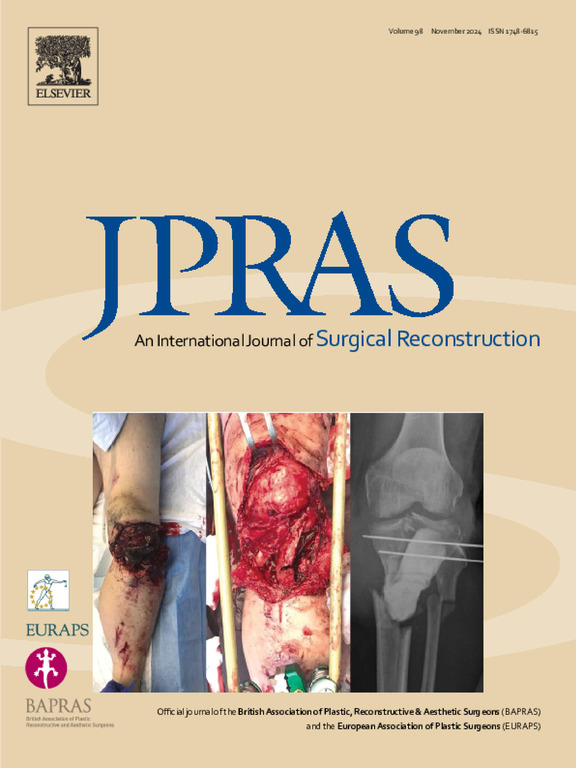内侧上髁切除术治疗肘管综合征:来自8年回顾性队列研究的结果
IF 2.4
3区 医学
Q2 SURGERY
Journal of Plastic Reconstructive and Aesthetic Surgery
Pub Date : 2025-07-11
DOI:10.1016/j.bjps.2025.07.007
引用次数: 0
摘要
背景:肘管综合征(CuTS)反映了由于肘部压迫导致的尺神经功能障碍。关于最佳管理没有共识,文献中有相互矛盾的证据。本研究旨在报道内侧上髁切除术(ME)治疗切口的临床结果和并发症发生率。方法采用回顾性队列研究方法,在同一中心进行了8年的外周神经手术的肘管减压联合内上髁切除术。结果分析需要至少24周的随访。采用McGowan分级和基线神经生理学研究评估疾病严重程度。临床结果采用威尔逊-克劳特报告系统评估疾病对干预的反应。我们使用方差综合检验和线性回归模型比较主要结果变量(McGowan分级),以评估不同术中发现对临床结果的影响。结果共纳入185例患者。82%的人的威尔逊-克劳特评分为“好”或“优秀”。患者在术后前6周表现出显著改善(MD = 1.065, 95% CI = 0.90 - 1.23)。然而,在6至24周期间,没有统计学意义上的显著改善(24 MD 0.168, 95% CI - 0.01 - 0.35)。摄入时严重的神经生理评分与较差的结果相关(Df 5, X2 = 2.37, F = 3.69, p = 0.004)。手术并发症的总发生率为7.6%,但没有明显的肘部不稳定。结论微创手术治疗肘管综合征是一种安全的治疗方法,并发症发生率可接受。本文章由计算机程序翻译,如有差异,请以英文原文为准。
Medial epicondylectomy for cubital tunnel syndrome: Outcomes from an 8-year retrospective cohort study
Background
Cubital tunnel syndrome (CuTS) reflects ulnar nerve dysfunction due to compression at the elbow. There is no consensus regarding optimal management, with conflicting evidence in the literature. This study aimed to report the treatment of CuTS with medial epicondylectomy (ME), including clinical outcomes and complication rates.
Methods
A retrospective cohort study of cubital tunnel decompression with medial epicondylectomy was conducted over an 8-year timeframe at a single centre for peripheral nerve surgery. A minimum of 24 weeks of follow-up was required for outcome analysis. Disease severity was assessed using McGowan grading and baseline neurophysiology studies. Clinical outcomes were rated using the Wilson-Krout reporting system for disease response to intervention. We compared the primary outcome variable (McGowan grade) using anova omnibus test and linear regression models to assess the effect of different intraoperative findings on the clinical outcome.
Results
In total 185 patients were included. 82% had a Wilson-Krout grade of Good or Excellent. Patients showed significant improvement during the first six weeks after surgery (MD 1.065, 95% CI 0.90 - 1.23). However, no statistically significant improvement was noted in the period between 6 and 24 weeks (24 MD 0.168, 95% CI −0.01 - 0.35). A severe neurophysiological score at intake was associated with worse outcomes (Df 5, X2 = 2.37, F = 3.69, p = 0.004). The overall rate of complications from performing ME was 7.6%, but no elbow instability was evident.
Conclusions
ME is a safe treatment option for cubital tunnel syndrome with an acceptable complication rate.
求助全文
通过发布文献求助,成功后即可免费获取论文全文。
去求助
来源期刊
CiteScore
3.10
自引率
11.10%
发文量
578
审稿时长
3.5 months
期刊介绍:
JPRAS An International Journal of Surgical Reconstruction is one of the world''s leading international journals, covering all the reconstructive and aesthetic aspects of plastic surgery.
The journal presents the latest surgical procedures with audit and outcome studies of new and established techniques in plastic surgery including: cleft lip and palate and other heads and neck surgery, hand surgery, lower limb trauma, burns, skin cancer, breast surgery and aesthetic surgery.

 求助内容:
求助内容: 应助结果提醒方式:
应助结果提醒方式:


